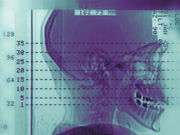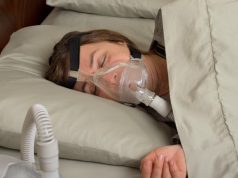Mean extracranial zygoma thickness is the same for those with, without obstructive sleep apnea
FRIDAY, May 4, 2018 (HealthDay News) — Obstructive sleep apnea (OSA) is associated with thinning of the calvaria and skull base, according to a study published online May 3 in JAMA Otolaryngology-Head & Neck Surgery.
Cyrus Rabbani, M.D., from Indiana University School of Medicine in Indianapolis, and colleagues conducted a retrospective cohort study of 1,012 patients who underwent a polysomnogram and had high-resolution computed tomographic imaging of the head. Patients with and without OSA (56 and 58 patients, respectively) were matched for age and body mass index.
The researchers found that patients with OSA had thinner mean calvaria (2.73 versus 2.47 mm; difference, −0.26 mm [95 percent confidence interval, −0.49 to −0.04]) and thinner skull bases (5.03 versus 4.32 mm; difference, −0.71 mm [95 percent confidence interval, −1.23 to −0.19]). The mean extracranial zygoma thickness was the same for those with and without OSA (4.92 versus 4.84 mm; difference, −0.07 mm; 95 percent confidence interval, −0.39 to 0.24). In nearly twice as many patients with versus without OSA, the tegmen mastoideum was dehiscent (37 versus 20 percent; difference, 17 percent; 95 percent confidence interval, 0.4 to 32).
“OSA was independently associated with intracranial bone (calvaria and skull base) thinning and not with extracranial (zygoma) thinning,” the authors write. “These findings support a possible role of OSA in the pathophysiologic development of spontaneous cerebrospinal fluid leaks.”
Copyright © 2018 HealthDay. All rights reserved.








